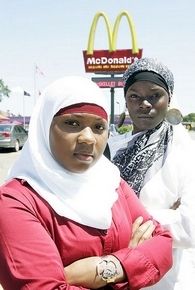 “The Greeks, as we all know, used to compete in the original Olympic games stark naked and smothered in olive oil. That’s no longer the fashion – because we have different cultural ideas about what parts of the body are suitable for public display – and, in fact, some women have taken the trend for Olympic modesty one stage further.
“The Greeks, as we all know, used to compete in the original Olympic games stark naked and smothered in olive oil. That’s no longer the fashion – because we have different cultural ideas about what parts of the body are suitable for public display – and, in fact, some women have taken the trend for Olympic modesty one stage further.
“This year, several women, including Egyptian fencer Shaimaa El Gammal and Bahraini sprinter Rakia Al Gassra, will be competing wearing the hijab.
“I suppose that as a good liberal feminist I ought to be appalled by this, seeing it as a symbol of patriarchal oppression. In fact, I find I rather admire these women.
“I am appalled by the fact that some countries, including Saudi Arabia, have sent male-only teams to the games. But for these women, combining their religious beliefs with their athletic ambitions, I have nothing but respect.
“A lot of rubbish is talked about the hijab. Since France banned girls from wearing them in schools in 2004, there has been a steady stream of media stories and comment suggesting that Britain should do the same. Feminist friends tell me that the headscarves are a symbol of female subjugation, a way to deal with male lust by forcing women to cover up, and that as such, they should not be tolerated in a gender-equal society. The women who wear them, they say, have been pressured into it by their communities.
“Well, yes and no. We all wear the kind of clothes we wear partly because of social pressure – and our own culture still says, for example, that it is more acceptable, and less sexual, for men to walk down the street topless than it is for women. Many patriarchal religions do indeed hold highly disturbing views about women, which should be challenged, but we should confront those ideas via education and debate, not by forcing young women to reveal parts of their bodies they would rather keep covered. If women say that they want to wear a headscarf, I’m afraid we have to take them at their word. What could be more anti-feminist than telling women that they don’t really know what they think?

 The women in Roqaya Al Ghasara’s home town in Bahrain are so proud of their pioneering Olympic sprinter that some of them got together to design and sew a set of tailor-made aerodynamic veils for her to run in.
The women in Roqaya Al Ghasara’s home town in Bahrain are so proud of their pioneering Olympic sprinter that some of them got together to design and sew a set of tailor-made aerodynamic veils for her to run in. DEARBORN, MICH. — Two Muslim women say the manager of a McDonald’s restaurant refused to hire them and insulted them during job interviews because they wear traditional Islamic dress.
DEARBORN, MICH. — Two Muslim women say the manager of a McDonald’s restaurant refused to hire them and insulted them during job interviews because they wear traditional Islamic dress.